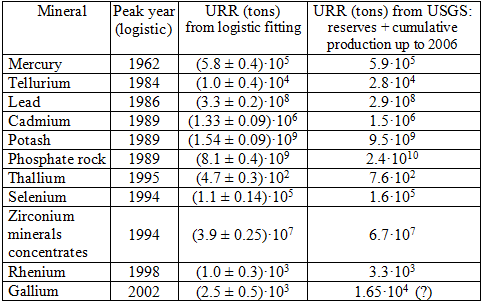"...There are two limiting factors. One, mentioned only in passing in the report, is phosphate..."
Today Energy Balance tipped us to this post at The Oil Drum:
Abstract: We examined the world production of 57 minerals reported in the database of the United States Geological Survey (USGS). Of these, we found 11 cases where production has clearly peaked and is now declining. Several more may be peaking or be close to peaking. Fitting the production curve with a logistic function we see that, in most cases, the ultimate amount extrapolated from the fitting corresponds well to the amount obtained summing the cumulative production so far and the reserves estimated by the USGS. These results are a clear indication that the Hubbert model is valid for the worldwide production of minerals and not just for regional cases. It strongly supports the concept that “Peak oil” is just one of several cases of worldwide peaking and decline of a depletable resource. Many more mineral resources may peak worldwide and start their decline in the near future....

...Perhaps the only case were the a decline of production can be attributed to market factors is that of potash (K2O) that peaked at a value of cumulative production considerably lower than midpoint and where market factors were indeed reported as the cause of the decline (USGS 2006).
The paper referred us to the USGS' 2006 Minerals Yearbook: Potash
Now I have to figure out what it means to AGU, MOS and POT.
Phosphate and potash. And nitrogen, oh my!
Happy Halloween.